

Regardless of the type of property being managed, the principles of resident and tenant relations are essentially the same. In fact, the cycle of tenancy is common to all properties. The current tenants once started out as prospects who were attracted to the property for one reason or another. Some tenants eventually move out, but satisfied tenants may refer others to the property. When leases expire, the tenants’ satisfaction with the location, appearance, and structural integrity of the property are important factors in their decision to renew the lease. However, tenants are less inclined to move out of a property after specific programs are implemented that are designed to retain them. This chapter explores all phases of the cycle of tenancy, along with the skills and dedication required of the real estate manager.
Marketing real estate is different from marketing other types of products and services. Obviously, real property is immovable, so altering it to meet market demands is difficult and expensive. Specific features of a property may limit the size of its market and the number of its potential tenants. Therefore, real estate managers (or leasing agents) must thoroughly understand the property’s features before identifying the market, and concentrate promotion in media appropriate to that market. Careful study of the limitations on the market before initiating a marketing program will reduce the time and expense required to produce results.
Four primary factors limit the potential market: (1) property type, (2) size of the rental space, (3) location, and (4) rental price. Property type limits leasing agents who need to determine whether they are marketing store space to merchants, office space to businesses, or apartments to people looking for a place to live. Each of these property types requires a different marketing approach.
The second limiting factor, size of rental space, narrows the range of potential tenants for a specific store, office space, or apartment. For example, the number of employees and size of equipment help determine the square footage needed for the office space. For commercial properties, supermarkets must have 50,000 or more square feet of space—some require 100,000 square feet—while a gift shop usually requires 2,000 square feet or less. In terms of residential space, members in a household and their income generally define the size and layout.
Location, the third limiting factor, also relates to the type of property. Specific features, such as access to transportation and proximity to local attractions, define the market as well. Shopping centers can seek tenants nationally, but rental housing and office space generally attract prospective tenants from the surrounding neighborhood or region. On the other hand, a time-share condominium in a resort area may attract residents from all parts of the country or the world, depending on what they can afford, which leads to the fourth limiting factor—rental price. Any particular level of rent will attract only those in the market who are able to afford the rent and are willing to pay it.
Once the general characteristics of the tenant profile become evident, real estate managers can examine what will attract the greatest number of prospects to visit the site. The effort at this point is to make the market aware of the property’s existence, its advantages, and its available space. It is important to ensure that the property will lease up quickly by choosing the medium and message that will generate the most responses—the greater the number of responses, the larger the number of prospects. Many types of media are available to market a property, but when selecting media, consider two key elements: (1) reach and (2) frequency. Reach applies to the specific audience exposed to the medium, and that should be the largest possible number of prospects who mirror the target market. The frequency is the number of times the ad appears in the medium.
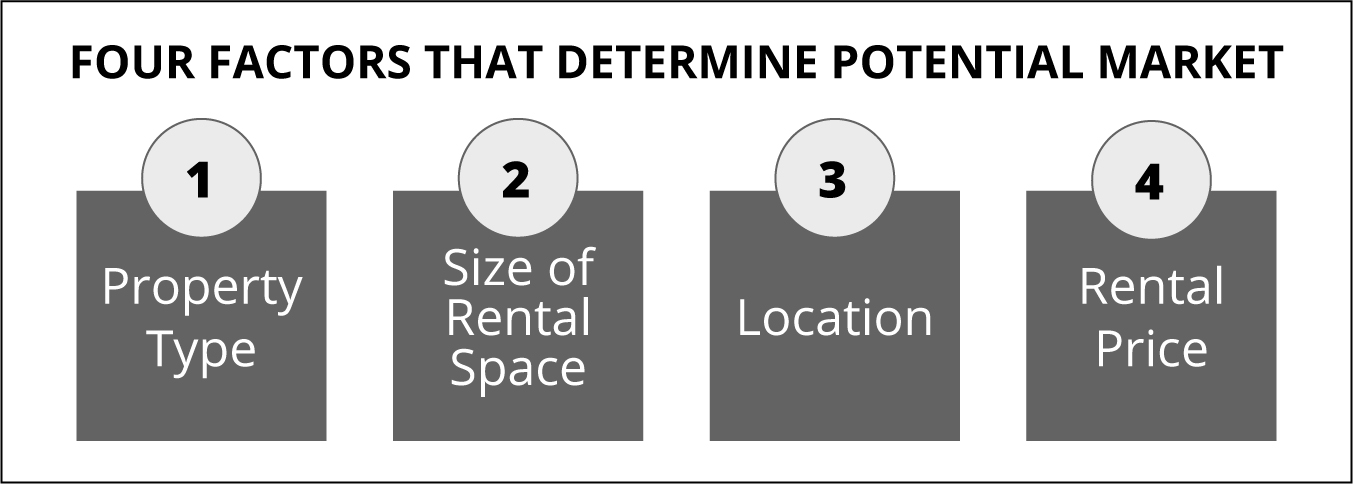
By its nature, a new property attracts attention. Its location, size, and state of completion invite curiosity. In this regard, a new development benefits from the free publicity it receives simply because it is new. People’s natural inquisitiveness can be further encouraged with specific advertising. On the other hand, an older property may not generate much curiosity, but compared to a new structure, an established property may have fewer vacancies to fill.
New residential properties usually have impressive model units that contain furniture and accessories, which should reflect the market and ideal tenant (Exhibit 8.1). Model units also help prospects envision the space as their home. While the furnishings of a model space should suit the target market, the furnishings themselves should not be the focus of attention—they should subtly enhance the space, not overshadow it. Oftentimes a prospective resident may request a viewing of an unfurnished, vacant unit in order to fully envision the space without the model decor (Exhibit 8.2). When leasing office or retail space, models are rarely a factor in obtaining tenants. These spaces will typically be marketed in a vanilla shell condition—walls ready for paint, floors ready for flooring, and a restroom with standard finishes.
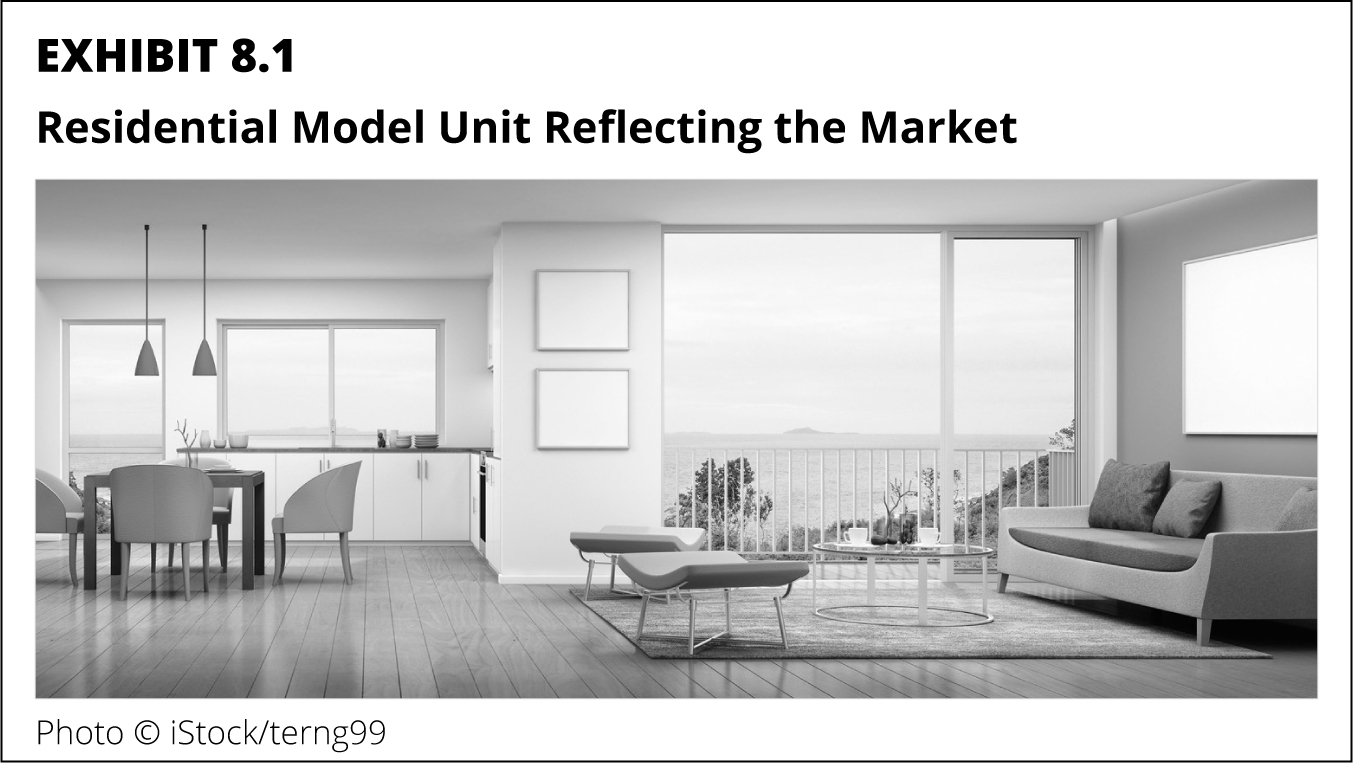
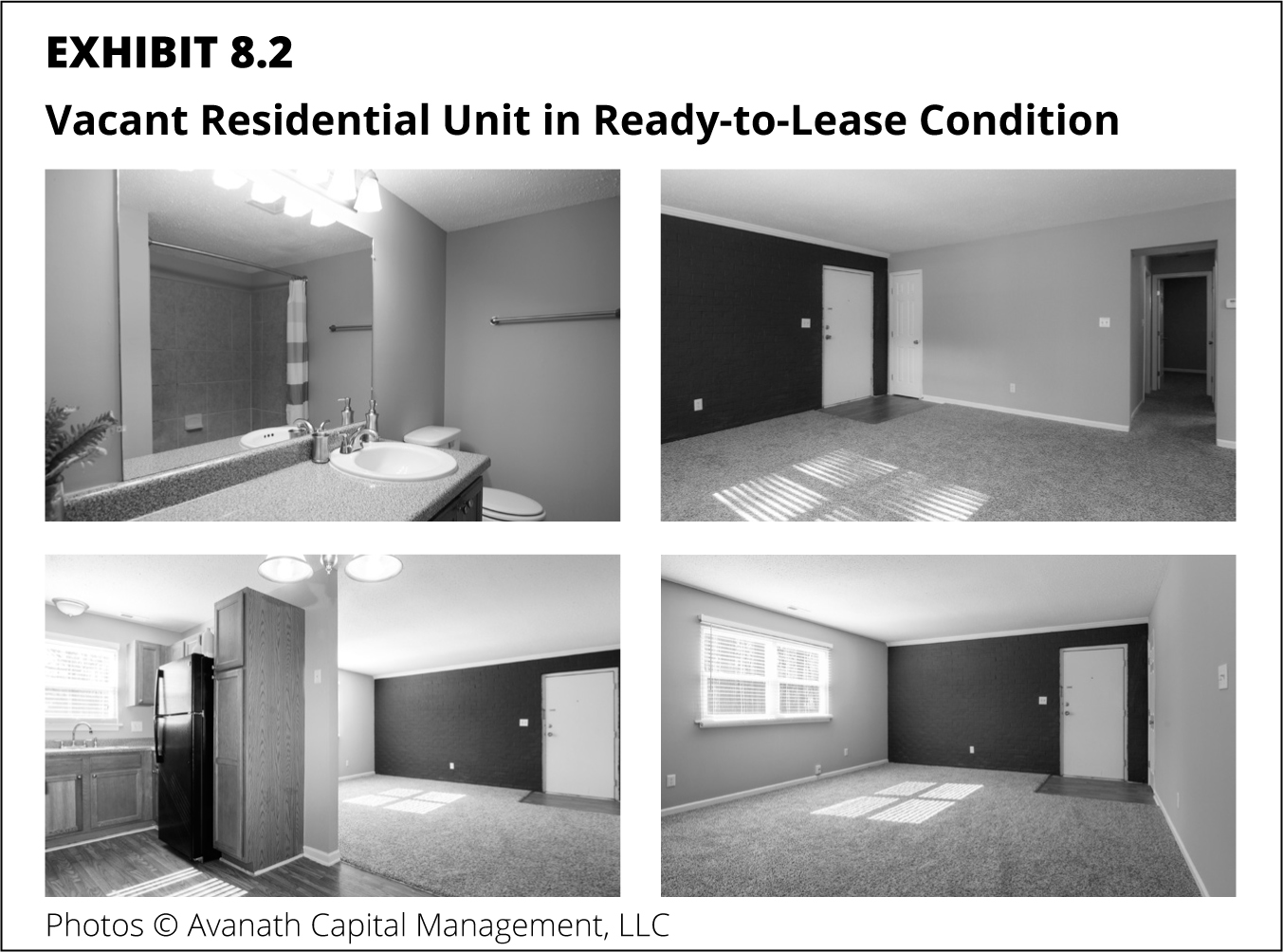
The first step in developing a marketing program is to consider the costs of advertising and promotion in order to quantify how much money is available because an advertising program generally requires its own budget. The second step is to determine whether (and to what extent) to use an advertising agency. Although more common with new construction because of the extra expense involved, real estate managers typically hire advertising agencies to promote very large developments or a group of properties under one ownership. When considering an advertising agency, verify the extent of the services desired, the precise cost of those services, and the length of time the contract will last. The costs for these services may include but are not limited to the following:
A comprehensive marketing program includes a variety of media, and it should never exclude existing occupants. Funds should always be specifically allocated to retaining occupants, which is explained later in this chapter.
After assessing the budget and costs, the final step is to utilize the information that is uncovered from the market analysis to determine the target market—the ideal tenant, who might be interested in renting at the property. For example, the target market for residential properties is usually composed of a particular age group or income bracket, matching the current resident profile. For commercial properties, certain tenants will be targeted in the attempt to achieve the desired image and tenant mix for the property.
The sections that follow explain the different advantages and disadvantages of promotional methods that help target a certain market. These methods involve developing a theme—a concept that is reflected across all marketing efforts, conveyed through a name, logo, design, fonts, color scheme, etc., and appears in signage, brochures, and the property website. This theme functions as branding that sets the property apart from its competitors.
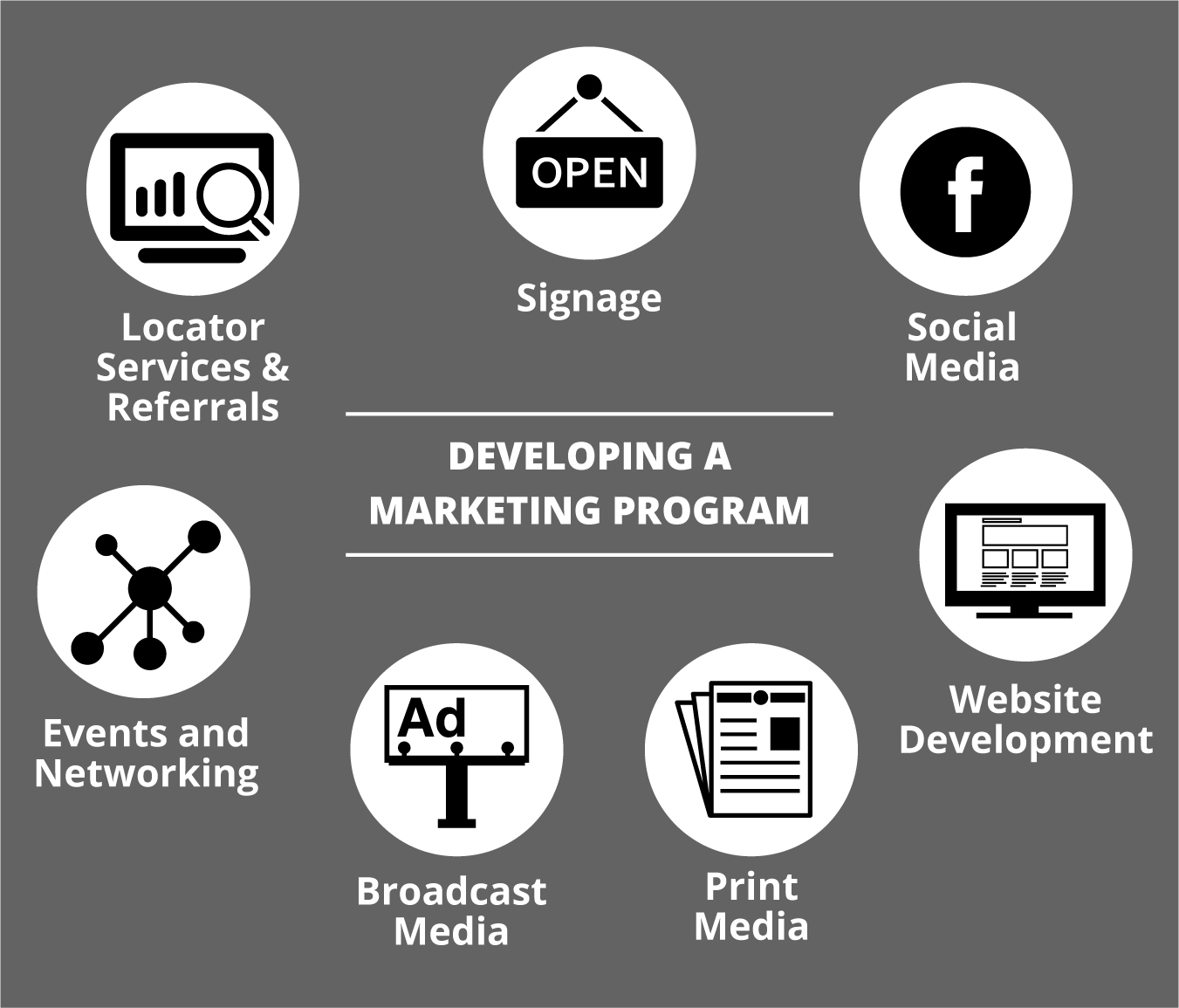
Signage. Every property, whether it has vacancies or not, should display a well-designed and easy-to-read sign that is one of the first things a prospect will see. Good signs identify the site, show the name of the managing agent or firm, and have information on how to obtain rental information. Basic signage is durable and requires minimal maintenance, while providing a continual, cost-effective form of advertisement. Although the response to on-site signage is promising, it also has an understandably limited effectiveness. Only people passing the property will notice the signs, and they may already know the information, which is why signage alone is not adequate—other forms of advertising should accompany it. Marketing signs and other promotional gimmicks, such as brightly colored banners, tall flags, or balloons, are sometimes used throughout a property or near a specific vacancy to immediately grab attention (Exhibit 8.3).
A building’s signage conveys a certain impression about the property. The property name, logo, or other symbol used to represent the property should appear consistently in all signage to maintain the unified theme. The following lists the five types of signage:
• High-rise buildings—an engraved plaque may be coordinated with the building exterior
• Commercial properties—signs placed on or above doors to indicate entrances, exits, and unit or suite numbers or special rooms (e.g., leasing office, laundry room)
• Temporary signs—occasionally used to warn tenants about a malfunction (wet floor or wet paint); should be immediately removed once the problem is corrected
• Handwritten signs—usually mismatched; detract from a building’s overall image
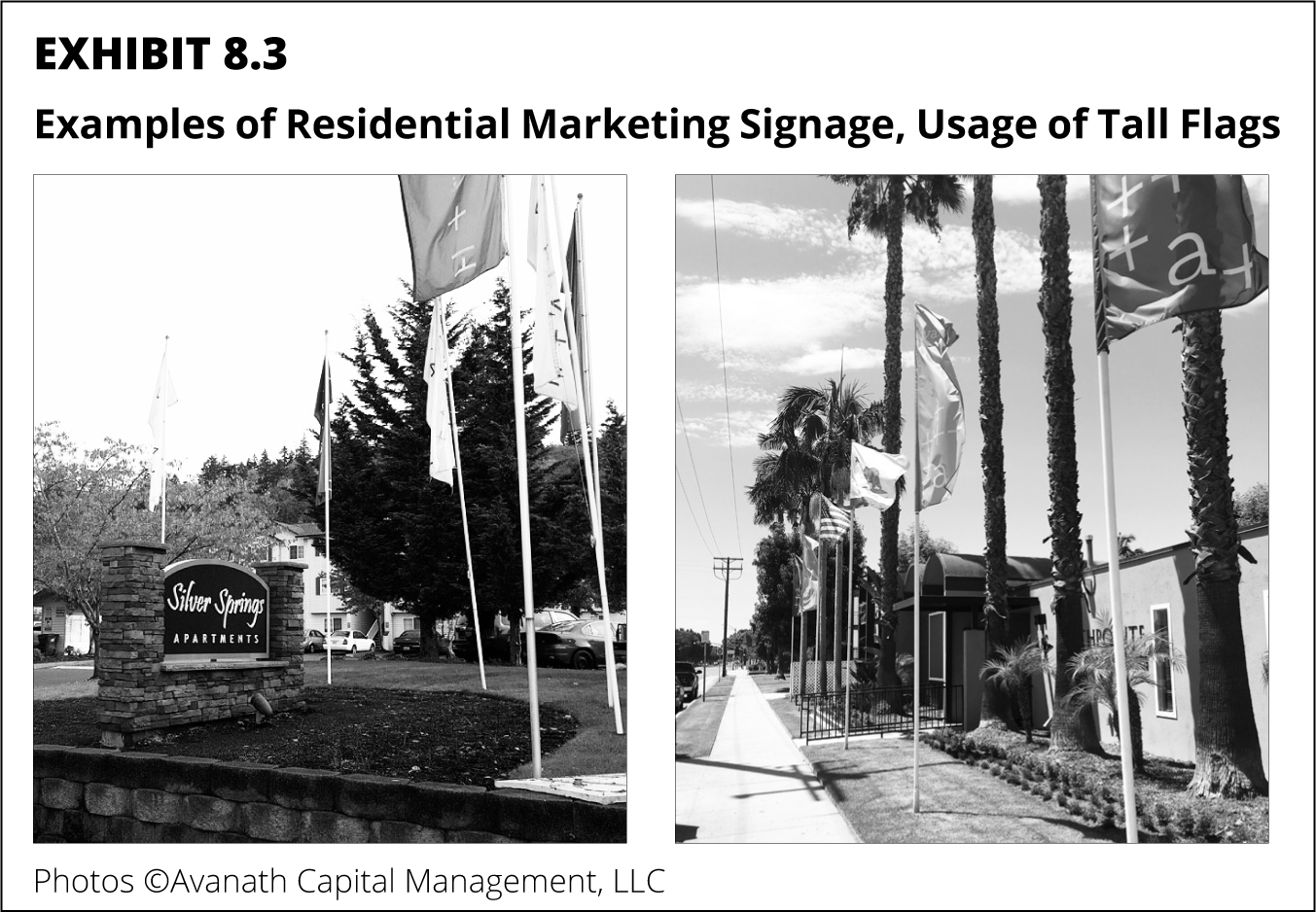
Social Media. There is no form of marketing or advertising more confused, misunderstood, or inappropriately used than social media. Simply put, it’s a method of communication that provides advertisers with direct access to their potential customers; however, this direct access is not a blanket authorization to commence a sales pitch. Instead, it’s the opportunity to demonstrate (Twitter, Facebook, Blog) or illustrate (Pinterest, Instagram, Facebook, Tumblr) just why the property is ideal (Exhibit 8.4).
If the property has planned events centered around the holidays, great tenant functions to showcase, a seasonal special, or great reviews on Yelp, Google, or Facebook, it should be featured in whatever social media platform(s) chosen. A great aspect about social media is that it is free, but in order to maximize the overall message, it’s important to create content that is easily liked, linked, accessed, and shared—start small and simple.
There are a number of third-party firms that can assist with monitoring the conversation surrounding the business in the social media sphere. Simply following, responding, and encouraging customers to communicate is key because it’s a way to demonstrate that management is available and listening to concerns. Certain responses can be predrafted so they are quick and demonstrate urgency. If the approach and messages are thoughtful, helpful, and service driven, it assists in reinforcing the property’s brand and image and almost always translates to lower turnover and higher occupancy.
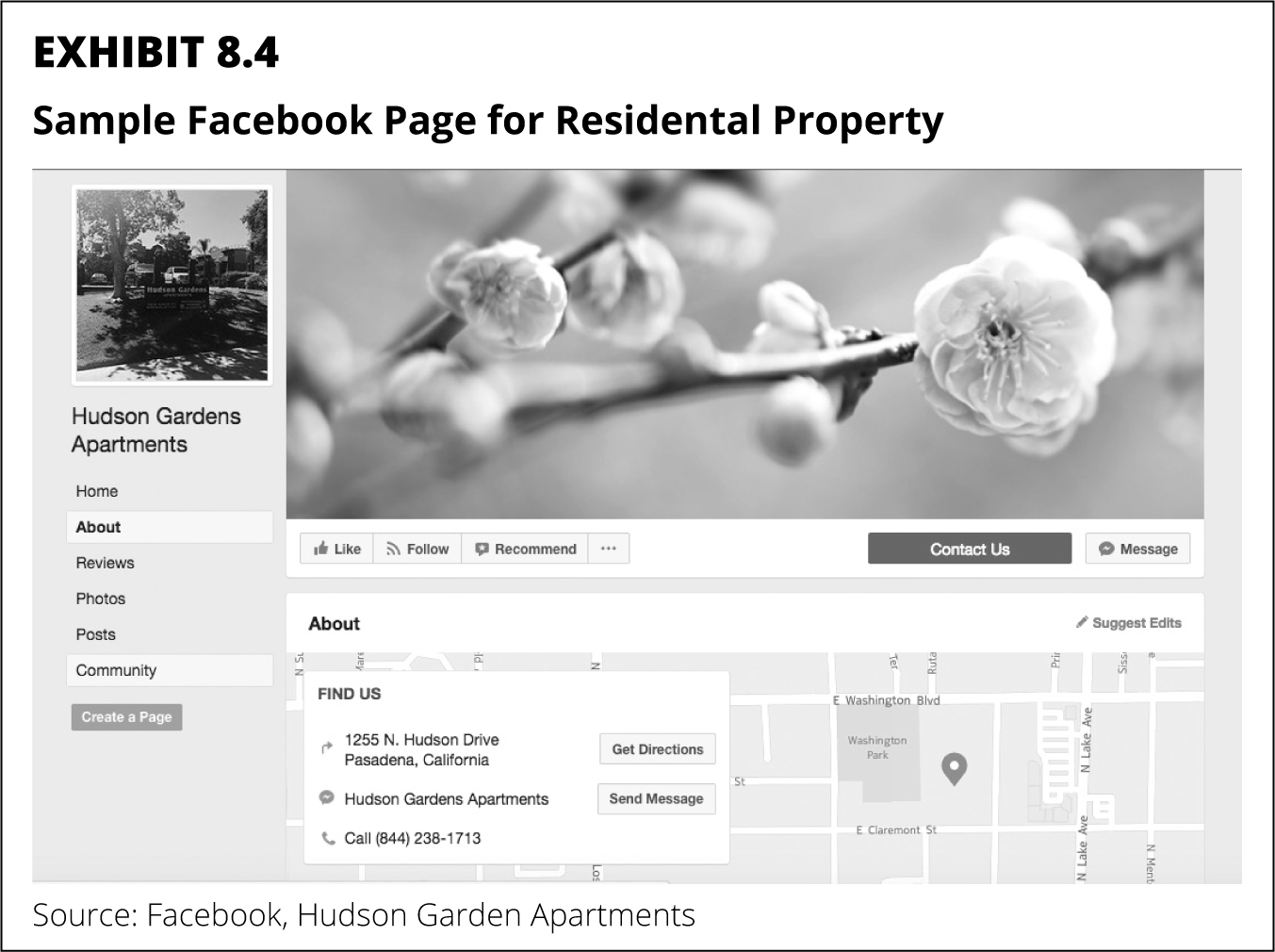
Website Development. Posting information online is the most fundamental resource for potential tenants and residents. Whether a custom website is maintained for a property (or company) or listed on another website, these media are relatively inexpensive and reach a wider audience. Depending on the listing, a property can be promoted as a featured listing on the homepage of other high-profile areas. Residential leasing websites such as apartments.com, apartmentguide.com, and craigslist.com advertise millions of units nationwide.
Commercial leasing websites such as cityfeet.com and loopnet.com list over two billion square feet of space. In addition, regional websites post vacancies for the local area, which allow potential occupants to search for available space using geographic parameters, square footage requirements, and rental rates, among other qualifiers. Search results include photographs, plans, detailed property information, and leasing contact information. Most websites include a virtual tour to view a revolving image of the interior or exterior of a property.
Also popular with consumers are sites such as Hotpads.com, Zillow.com, and Trulia.com, which allows users to access a more information-based search. Rather than the typical sales pitch with click bait, Zillow.com provides more of a research tool to allow users to access neighborhood information, rent comps, and additional data before making a decision on whether or not to sign a residential lease.
Creating a custom website and maintaining the information on it requires specialized design skills and involves either a flat rate or ongoing costs, whether it is for a property management company or property (Exhibit 8.5). Certain designers might charge as low as $400 and as high as $2,000, depending on the features and style used. Some website designers are also experienced in logo design and might have other specialized skills that can be used in the overall marketing of the property. Common features in property websites are links to applications for housing that include easy payment of application fees, and maintenance requests.
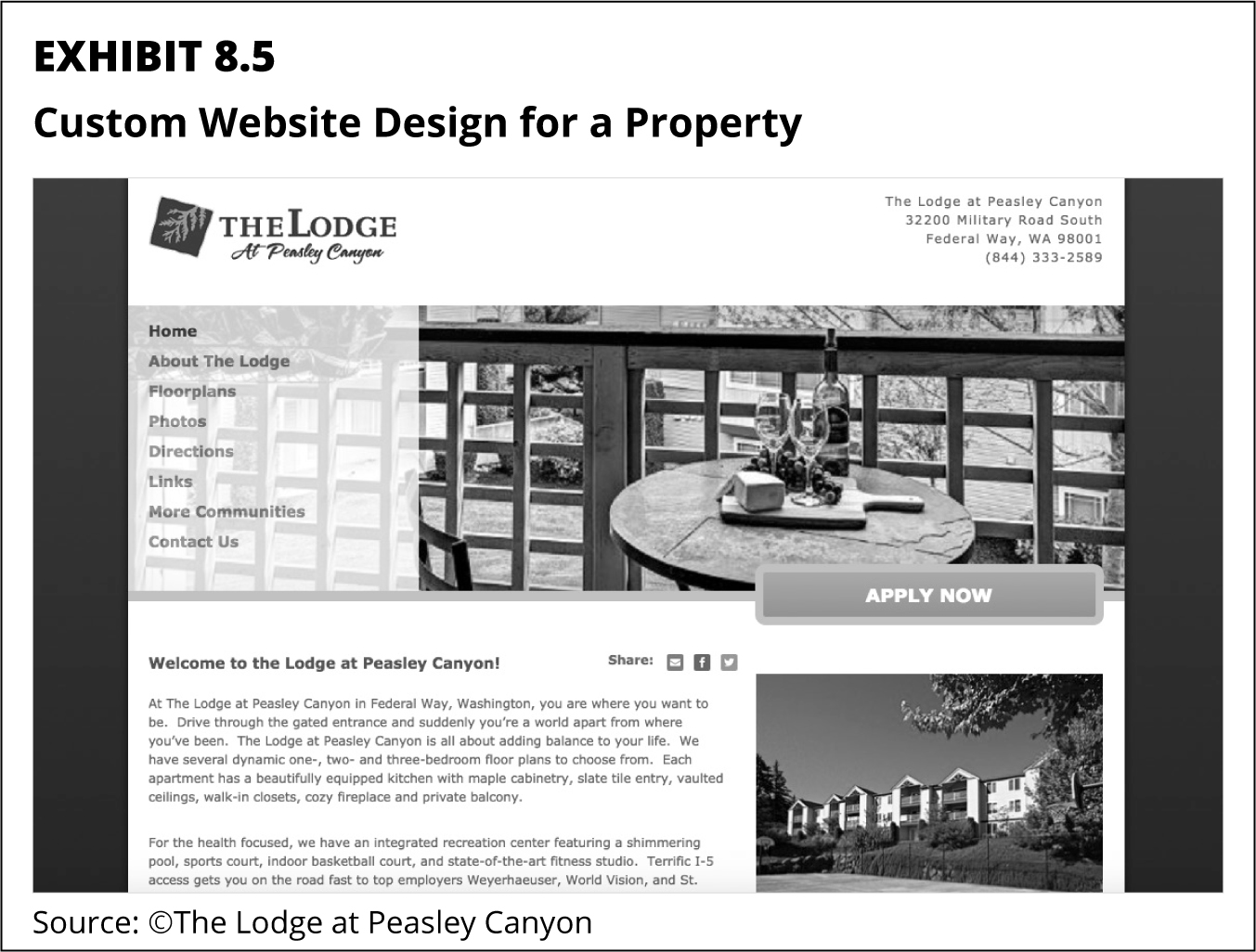
Print Media. Certain publications accept display ads that are larger and more expensive than typical print ads. Display ads are usually placed in apartment guides or commercial guides that are distributed free of charge—especially in major cities. Real estate managers of office buildings can advertise in magazines, journals, bulletins, and monthly newsletters directed to a specific industry—for instance, the medical field. For shopping centers, specific publications directed to general retailing audiences, as well as to specific types of retailers help gain prospects. Display ads are most helpful during initial lease-up of any type of property and are very effective for inviting a broader audience to visit a new or renovated building.
As with many industries, the need for print media and advertising is slowly fading. More and more service providers are switching to online or hybrid in-print and online platforms that allow clients and customers to obtain the maximum return on advertising investment possible. Online advertising allows for greater exposure, interactive, and virtual tours, as well as enhanced tracking tools to better understand what works and what does not. In fact, many real estate owners and operators are switching to online only for their marketing collateral.
While they are used far less, some newspaper ads are still placed in certain markets. Newspapers with larger circulations periodically publish a special section on real estate that appears in a magazine or tabloid format including information on properties, neighborhoods, property owners, real estate brokers, developers, and managers, and appeals to numerous readers. The real estate manager must weigh the appeal and potential success of advertising in these special sections because they usually carry an added cost.
Brochures, Letterhead, Forms, and Business Cards. The most detailed piece of advertising for a property is usually printed in a brochure with colorful and appealing, high-quality photos that fully describe the property and rental space. Brochures are usually available to hand out to prospects, and they can be mailed to those who inquire by phone or be distributed to local businesses for employee break rooms, etc. For residential properties, brochures should include sample floor plans with photos of the model spaces. For shopping centers, they should include a plot plan, traffic statistics, consumer demographics, and sometimes aerial photographs of the site and the neighborhood. Office building brochures should have information about the amenities and nearby facilities along with photos. Depending on the particular company, brochures can also list the name of the management company and their contact information.
To minimize costs, before a brochure is designed, consider how long it will last. For example, a design that allows updating information on rent prices will help a brochure last several years. The same primary design elements (logo, typeface, and graphics) should be used to maintain the consistency and general theme. To design a brochure, various design software programs allow businesses to easily customize the software as needed. Depending on the budget, the cost differences must be weighed between purchasing the design software and contracting a graphic designer.
Coordinated business cards, forms, documents, and company letterhead maintain a unified theme and branding for the company or property. Such printed forms should contain the same font styles, logo, and graphics. They work together to establish the reputation of a property as being on the cutting edge or more modern compared to other properties that might appear older and out of date.
Direct Mailing and Press Releases. If legitimate prospects for a particular property can be identified, a direct-mailing campaign may be profitable, but identifying prospects can be problematic. While producing, printing, and mailing an ad is costly, preparing or purchasing mailing lists is usually even more expensive. Most purchased lists are ineffective for reaching rental space users directly; however, lists of brokers who represent tenants (or tenant reps) are useful for leasing office, retail, and industrial space. Because of the costs involved, direct mailing is not a primary means of promoting rental real estate, but it can be effective if sent to a targeted market and followed up with a personal contact. Much of this is effectuated in today’s market via eBlast and other commercial marketing sources that generate and send e-mail solicitations to target audiences.
Press releases are sent to real estate editors of local newspapers as well as broadcast media outlets in the form of direct mail or e-mails. When sending press releases, be sure they are newsworthy items for local publications and broadcast media. For example, information about a new development or a property that has undergone substantial rehabilitation can lead to rental inquiries at virtually no cost. The presentation should be clean, attractive, and free of errors. Including the following items in a press release will help attract an editor’s attention:
Press releases should be maximized for their publicity and public relations value, even though they do not replace the effectiveness of advertisements. Developing a relationship with the real estate editor of the local newspaper can be beneficial—especially when announcing events, such as grand openings or the reopening of a property.
Broadcast Media and Billboards. Real estate managers occasionally use TV or radio commercials to lease a new residential development or to promote tenant businesses in large shopping centers. TV commercials are extremely expensive because both production and airtime costs are high. The cost of airtime is usually much lower for local channels than for network television, and the advertisement can target a specific market based on the particular channel’s programming. Radio promotion is primarily useful for residential space, although office and retail space may benefit from advertising on all-news or business stations or programs. For instance, Saturday or Sunday afternoon radio commercials may effectively direct drivers to open house showings. In some aspects, radio has advantages over television—it is less expensive and serves narrower target markets compared to certain TV stations.
Another advertising option on a larger scale is through use of billboards, especially for new or renovated properties. Billboard messages are concise; they announce the location, type of space, and projected occupancy date of the property. The size and content of billboards are influenced by the volume and speed of traffic passing the sign, based on its location—whether an intersection, a highway, or a public transportation station. Since billboard advertising is expensive, it is important to simply announce that space is available for lease and provide basic contact information.
Events and Networking. Unlike advertising, public relations (PR) refers to any form of promotion that is not paid for, such as press releases and word-of-mouth endorsement. PR helps increase awareness and build the image of the property in a cost-effective way. Clearly, creative public relations can affect the target market at a fraction of the cost of advertising. In fact, some experts say that consumers are five times more likely to be influenced by editorial copy than by advertising. Special events such as a Halloween Trick-or-Treat through the property or even an Easter Egg Hunt at the site will generate news and attention. Another important way to help build clientele and expedite leasing is through membership and active participation in professional organizations and social networking events they might host. This allows real estate managers to make use of business and professional contacts. For example, attending annual conferences and participating on committees and boards are ways to increase this interaction. Many associations offer opportunities to teach their courses throughout the country and internationally.
Locator Services and Referrals. Real estate managers must budget their use appropriately when relying on locator services and referrals because both services require compensation. Locator services are more common in the apartment market, and they often assist people who are relocating into the area. They provide a centralized listing of available rental space and usually offer their services directly to the prospect. However, the property owner whose space is rented usually pays the fee—typically a percentage of the first month’s rent.
For commercial markets, leasing agents and real estate brokers provide a similar service to owners and prospective tenants through referrals. These representatives seek out prospects if they work for an owner. If they are tenant reps, they search for office, retail, or industrial space that meet the prospect’s criteria. The broker’s fee (leasing commission) relates to the negotiated rent. In a soft market, the owner of the leased space pays the fee. In a tight market, the tenant may have to pay the commission. Commercial brokers and leasing agents are often part of a network. (The local Commercial Board of REALTORS® provides a gathering place to exchange information.) Many have multiple-listing services and mechanisms for distributing flyers on available properties to their members. They may refer properties or prospects to other brokers if they are unable to match a commercial tenant to a particular space. In such situations, a reciprocal arrangement may be made regarding commissions if a lease is arranged.
Referrals are excellent sources of prospects for any type of property. Happy residents and tenants actively discuss their satisfaction with friends and business associates; this can be encouraged by offering referral incentives, which should be carefully evaluated in terms of what to offer and the costs. A rental discount is usually an attractive incentive to offer; however, other incentives may be more effective for a residential property. The most popular forms of incentives include cash payments, rental discounts, gift certificates, or improvements to the leased space (new appliances or fixtures). Before instituting a referral incentive program, investigate any legal limitations on tenant referrals or compensation for them. Certain restrictions may relate to real estate licensing requirements—some states may prohibit monetary incentives.
In today’s social atmosphere, branding and messaging is more important than ever. From helping a company establish their presence in a market or submarket to repositioning or launching a new property, there are many reasons to create a brand, and crafting a catchy or creative logo and tagline is just part of it. Presenting the brand to customers and clients on and off site can make business more successful and also enhance occupancy.
There are three primary types of branding that occur on-site or across a portfolio, and each is directly related to the identity of the entity: (1) owner or ownership group, (2) management company, and (3) the physical asset.
The Property Owner’s Branding Goals. Depending on an owner’s goals and objectives, they may seek to advertise their name or brand at the site. While this tends to be more common with an owner/operator, it is not uncommon with investment groups or funds seeking to garner attention as an area expert—perhaps as they seek out off-market investment opportunities in a particular market or submarket. Additionally, it can help with fundraising if the group is active in the marketplace and looking to grow their investor base. There is no better way to evaluate the relationship between physical and financial oversight than to walk the property. Seeing the owner’s name and logo at the property level shows investors and customers that the owner stands by their product.
A secondary brand that has emerged in recent years is the lifestyle brand, where a company will launch a brand that is specifically tailored to meet a niche market. Historically, this has occurred in the hospitality sector with companies like the Marriott with their flagship Marriott brand, luxury JW Marriott brand and business-minded Courtyard by Marriott brand.
Multifamily companies such as Avalon Bay have three tiers, starting with Eaves, then Ava, and ultimately Avalon. Other regional/national players such as McKinley and Laramar have launched brands focusing on smaller, localized assets in specific markets. While McKinley has launched their Hyde Park brand in Tampa, Florida, Laramar has launched their “local” brand in Los Angeles that caters to a niche property type and allows them to market their brand to a specific “lifestyle” renter.
The Management Company’s Brand. The management company stands to benefit greatly from marketing their brand on site. Collateral can be proudly displayed in the interior and exterior common areas to identify the management company and direct interested customers and clients to contact the company for additional information on both their services or space available. The properties truly represent a physical “resume” of the management services, so through effective messaging and branding, it helps to ensure that the management company stands out as the local market expert. It’s important to understand the owner’s position on displaying the management company’s marketing on site. Placing items such as signs, banners, decals, stickers, flags, or other materials in public view can help drive customer and client traffic to both offices—leasing/management and corporate—all while adding additional elements of excitement to the property’s marketing opportunities. Benefiting from the management of a physical asset, there is great potential leverage for current successes into future third-party management opportunities.
The Property’s Brand. It is not uncommon for a property to undergo a repositioning project that will include a physical upgrade or overhaul, along with a name change. If a property has been owned for an extended period of time and an ownership group is looking to boost returns, it is also common for the rebranding to take place in accordance with said renovation efforts. A property might suffer or benefit from a name attached by a local, regional, or national developer. Unless the name and/or brand has changed when the renovation efforts start, which include physical upgrades and improvements, they can sometimes be lost on the market. Successful property brands will garner an appeal on their own, often tying into the local community, a neighborhood, or region. Branding the site is increasingly common and critically important in today’s world, where local lifestyle elements are sometimes the key to additional revenue and income streams.
It’s important to consider the property branding in conjunction with other on- and off-site marketing in order to ensure the property branding efforts do not just coexist but truly cooperate to maximize the overall marketing and branding efforts outlined in the property’s marketing plan.
The list of incentives and concessions that an owner can offer to new tenants is endless. Incentives to lease residential space tend to center on amenities such as free cable television, a lower security deposit, or interior decorating (paint, wallpaper). However, the choice of incentives should not detract from the property’s image or reputation. If possible, concessions should be aimed toward enhancing the property after a resident vacates, so that incentives do not lower NOI or decrease the property’s value.
Leasing incentives are typically offered to prospective tenants for office, retail, or industrial space. Examples include upgrading the tenant improvements or reimbursing part or all of their moving costs. For shopping centers, a modified percentage rent or caps on pass-through expenses may be granted. Market conditions as well as how desirable a particular space is to a particular tenant (and how desirable the tenant is to the owner) are considerations in offering such incentives.
Concessions. In areas with high vacancy and a poor economy or a large amount of new competitive space, offering concessions—free rent for a month as a marketing incentive—is common. Free rent is a costly concession for an owner to make; the reduction in NOI reduces cash flow and property value. However, if the market is poor and competitors are offering rent-free periods, the owner may have no choice but to offer such a concession.
Offering an incoming tenant a period of free rent technically reduces the amount of income derived from the rental space. However, the impact of this concession on property value and long-term income is not as great as a straightforward reduction of the rent—provided the rental space is priced competitively. When a financial concession seems necessary, the real estate manager and owner must strive to minimize the negative effects of the concession on NOI. At the same time, if a concession is not offered, the damage to NOI may be more severe.
Effective Rent. Real estate managers should understand the concept of effective rent in order to evaluate the ramifications of a rental concession accurately. Effective rent is the cumulative rental amount collected over the term of a lease expressed as an average monthly rental (residential) or an annual rate per rentable square foot (office, retail, and industrial). If a lease term is 12 months—more common in residential than commercial leasing—the effective rent is the total rent collected during the 12-month period.
When one month’s free rent is given as a concession, the effective rent is equal to only 11 months’ total rent. Averaged over the entire lease term of 12 months, this total is less than the quoted rent for the space per month—even though the full monthly amount is collected in each of the 11 months. However, a period of free rent is actually preferable to reducing the quoted rent because that may reduce the effective rent for many years—not just one. For commercial properties, everything is part of the negotiation process and effective rent and net present value (NPV) of the entire package must be considered, including time value of money since leases tend to be longer.
Exhibits 8.6 and 8.7 demonstrate this concept. The impact of lowering quoted rent is magnified when seen in the context of the whole building or property—more important; it reduces NOI and property value.
The effectiveness of each marketing effort (or advertisement) is measured in terms of the number of prospects who come to the property, the cost to reach them, the number of prospects who become residents or commercial tenants, and the length of time the space remains vacant. The amount of advertising needed depends on the occupancy level and location of the property. If the property is fully leased and no move-outs are expected, no advertising is necessary. However, most large buildings have continual turnover; therefore, continual advertising is essential. A prominent location may generate enough walk-in traffic at a residential property to reduce the advertising needed—less prominent properties may require significantly more promotion to achieve sufficient rental traffic. There are no set rules to determine how much advertising an individual property needs, but thinking of advertising as an investment underscores its monetary value. The return on this investment is finding a qualified tenant to fill a vacancy as quickly as possible.
With that in mind, advertising expenses can be calculated in terms of the cost per prospect. For example, $100 might be spent to advertise in an industry-specific publication to fill a vacancy in an office building. Because very few vacancies exist in the community, 10 prospects respond to this ad, and two of them are intent on signing a lease for this $800-a-month office space. The $100 investment certainly would be a value at a cost of $10 per prospect. The number of strongly interested prospects was two out of ten, making the prospect-to-tenant ratio five to one. This ratio is called the conversion ratio. The advertising cost, selected medium, and length of time before a new tenant is found must be evaluated in relation to the resulting conversion ratio to determine the effectiveness of a particular marketing campaign. In other cases, the conversion ratio is used to evaluate a leasing agent’s talents and performance against those of their peers.


Real estate managers commonly use a traffic report to record what attracted a prospect to visit the subject property. The example shown (Exhibit 8.8) is for a residential property; a traffic report for an office building would record similar information with the prospects’ space needs indicated as ranges of square footages. By evaluating traffic reports, the effectiveness of different marketing methods can be determined. The most effective approach is the one that produces the most prospects at the lowest cost per prospect in the least time. Today, automated software solutions help take the traffic report a step further by providing solution-specific phone numbers that are customized to fit a specific advertising method. For example, Zillow, Facebook, and Google are used, each number would be different. These numbers, once dialed, are tracked in the database and both site-level and off-site supervisors are able to access this information in real time to understand where most leads are coming from.
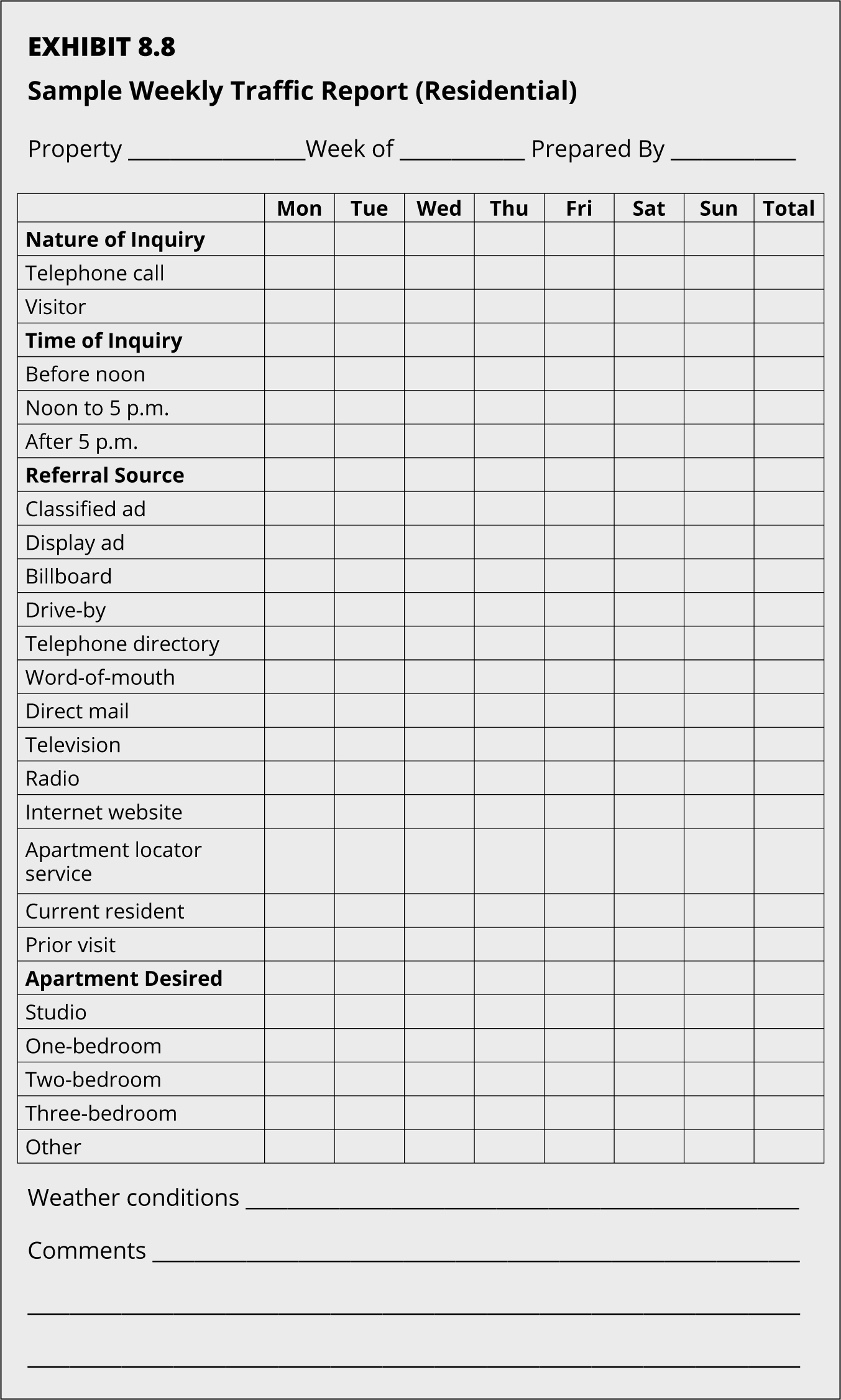
Since prospects usually become tenants only after visiting the property, certain sales techniques should be used to persuade prospects that they are receiving the best value to accommodate their needs. Sometimes the rental space may sell itself, but regardless of the condition of the available space, there is no guarantee. Real estate managers and leasing agents should master the following four fundamental leasing tactics:
All four are critical—the last is most important of all and must go beyond the obvious. For example, if prospects who are considering an apartment mention that they have children, simply saying, “There is an elementary school in the next block,” is not enough because the prospects are probably already aware of the school. Instead, leasing personnel should be able to volunteer detailed information about the school that goes beyond knowing the location. In fact, they should be thoroughly familiar with the neighborhood (schools, shopping, transportation, etc.) so they can answer specific questions as well as describe the setting in which the property is located.
A leasing agent who shows office space should be able to discuss features and businesses in the vicinity that may be of use to prospective office tenants and their employees. Examples are the proximity of business-to-business services such as attorneys, commercial banks, restaurants, health clubs, and public transportation. Information about the trade area population, traffic counts, and the competition (or lack of it) should be available for retail prospects. While answering questions and engaging in conversation with a welcoming, warm demeanor, the leasing agent will soon get acquainted with the prospect.
Multifamily property owners use tools such as LRO (lease rent options) or YieldStar® to set prices based either on market activity or trends or portfolio-wide occupancy. These tools, though intended to maximize revenue and occupancy to fit an owner’s goals and objectives, can be quite confusing for a prospect. The rent is customized to a specific point in time and as a result, the next prospect can sometimes receive a more or less favorable price quote for the same unit. In any case, the technology best demonstrates the need for a blend of old-school market expertise: knowing the competitors, their product, and their rates and strong sales skills. Things do not always go over well when the leasing agent’s response is “well, that’s what the computer says.” Computers and software can help so much in this business, but face-to-face interaction at application and move-in time are absolutely essential for building rapport and creating a favorable customer experience.
When it is time to show the space for lease, appearance is everything. Most prospects assume that models represent the best that the property has to offer and that any apparent defects in the model will be magnified in the rental apartments. The following are a few guidelines for showing model apartments:
For residential properties without model units, the condition of the vacant spaces is as important as the condition of a model would be. At all times, an assortment of vacant apartments should be in market-ready condition—thoroughly clean with all improvements made. These apartments should be inspected daily to ensure there are no issues when shown to a prospect that might pose objections to leasing. An inspection checklist for a residential property typically includes the following:
Extremely good leasing agents will be able to close the sale after conducting the property tour and showing evidence that the apartment meets the needs of the prospect. Most often, the prospect will be ready, but just needs a little push to start the application process.
Diligence is necessary to ensure that the prospect can and will pay the rent, care for the property, and be a cooperative resident or tenant. Most of the qualification process involves financial history, but it should include other pertinent credentials as well. For residential or small commercial properties, the prospect usually supplies the information on a rental application form. A credit bureau can verify information about current loans, activity on credit cards, payment history, and delinquent debts. Appropriate consumer reporting agencies, such as tenant-screening and reference-checking services, can provide other types of information, such as an applicant’s rental history. Managers may ask residential prospects to pay a fee for such a credit check, and they customarily leave a refundable deposit to reserve the space until the credit check is complete. However, some states require real estate managers to supply the prospect with written criteria (screening criteria) before the prospect completes an application and pays a fee. The screening criteria are based on credit reports to be obtained by making phone calls to verify employment history.
For larger properties, there is access to more advanced web-based screening services that help determine—within a matter of minutes—whether the applicant should be accepted or declined. The criteria notify prospects of the types of factors the real estate manager will be investigating for the fee paid. After reading the criteria, the prospect can decide to pay the fee or walk away if they know that they might not qualify for some reason. Another tool for screening a prospective tenant is the criminal background check, which can be secured through most tenant-screening companies. When the prospect is approved, the initial deposit should be applied toward the security deposit rather than the rent, and if any amount is due, the remainder of the security deposit should be collected when the lease is signed.
In compliance with the Fair Credit Reporting Act, prospects that are denied a lease based on a credit report must be notified in writing of the adverse action. A residential rental application should request the prospect’s current and previous addresses so both property owners can be contacted. The information they can provide about the prospect as their resident is not available anywhere else. To establish creditworthiness for commercial tenant prospects, financial statements, federal tax returns, etc., should be used for the entity legally responsible for paying the rent. (Qualification of tenants is discussed in Chapter 11 for residential and Chapter 12 for commercial, office, and mixed-used properties.)
Owners and real estate managers are not responsible for implementing the Customer Identification Program of the U.S.A. Patriot Act. However, they should verify the applicant’s identity and citizenship or immigration status because of the risk associated with renting to a terrorist and because of the increase in identity theft. Real estate managers routinely require photo identification in the form of a driving license; federal (green card) or state-issued identification; and foreign passport. The tenant’s file should include a copy of the identification record.
The prospect’s Social Security number (SSN) or individual tax identification number (ITIN) is another required critical piece of information. Issued by the Internal Revenue Service (IRS), ITINs are available to noncitizens who need to report income for tax purposes but are not eligible for SSNs. The Gramm-Leach Bliley Act, which became effective in July 2001, requires property owners and managers to safeguard personal and financial information collected from prospective tenants and to dispose of it properly to protect against misuse and identity theft. The information collected during the screening process must be kept in secure files and must be properly destroyed when appropriate.
The most important element in keeping tenants satisfied with their choice of rental space is to let them know that their business is valued. Thinking of and treating tenants as customers, rather than simply rent payers, fosters the notion that they are valued. Rent is usually a major expense for tenants, and for that, they expect the components of the building to operate properly and efficiently and the property as a whole to be pleasant, comfortable, and secure.
Building a business relationship with residents or commercial tenants requires months or even years, especially if the real estate manager is new to the site and some of the tenants have been there for several years. Any dissatisfaction with the previous manager or management firm must be dispelled. Tenant dissatisfaction can be very damaging in terms of current occupancy and the property’s future reputation. Real estate managers can rectify legitimate concerns such as deficiencies in service; however, regaining the respect of the tenants may be extremely difficult if service was substandard for a long time.
The efforts to retain tenants begin before they move in. Between the time that one resident vacates a unit and another moves in, the property staff should inspect the premises to make sure all components are operating and are properly installed. Thorough inspection and repair at this time will avert dissatisfaction on the part of the incoming resident. If a repair cannot be completed until after move-in, tell the new resident approximately when the task will be finished. Commercial property owners may lease vacant space as is, or they may completely gut the space to allow for new tenant improvement construction, in which case additional factors, such as specifications having been met and occupancy permits, may come into play.
Incoming residents and commercial tenants should receive a handbook that outlines the rules and regulations of tenancy as well as a list of important names and phone numbers. The handbook should define emergencies and non-emergencies. Management and staff of residential properties in particular may receive calls at any time of day or night, unless guidelines are provided. Although a resident should never be dissuaded from calling about a problem, they should be able to distinguish a repair that can wait from one that is a true emergency.
Residents and commercial tenants at times request improved services or products, and those requests should not be considered as complaints. Although some tenants may think the motto, “The customer is always right,” grants them the privilege to make outrageous requests or demands, most understand the limitations involved in operating a property. All requests should receive responses as quickly as possible. However, requests that are particularly complex may require research, and the real estate manager should advise the tenant of that fact and when an answer may be expected.
Not all requests can be granted, and delaying a negative response—saying someone else must make the decision or that the request is still under consideration—may be tempting. Saying “no” is never easy, but delivering bad news as quickly as good news will gain the confidence of most tenants. Tenants are typically more concerned about receiving an honest response than about having a problem corrected immediately. They would much prefer a forthright estimate of when a problem will be corrected to a promise that will not be kept. Sometimes, hearing “I’m sorry” is all the tenant needs.
Every communication with tenants is an opportunity to build goodwill. Special events sponsored by the property’s management (e.g., a picnic or outing for a tenant appreciation day) can build morale. Residential and commercial properties can use newsletters effectively to update tenants about events on or near the site or to provide other information that pertains to all building occupants.
Another retention strategy is to perform housekeeping tasks as tenants are entering or leaving the building so they can see what the management does for them. Seeing the work in progress, as well as the results, tends to make that work more valuable to the tenant—visibility adds value.
Sending written questionnaires or e-mails to determine whether service requests have been handled promptly and satisfactorily is another way to gain tenant retention. Exit surveys can be used to find out why tenants move out and ask them what improvements to their leased premises, the building itself, or the property’s amenities might have encouraged them to stay. Asking about the rent structure and the value they received is also a good idea, along with how they were treated by the manager, staff, and company as a whole. These surveys can also be provided online or via e-mail through services such as Constant Contact or Survey Monkey.
Throughout the cycle of tenancy, the real estate manager’s dedication to building goodwill is essential for the property to thrive. The property and its potential tenants should be examined in order to estimate the size and nature of the market to create a marketing strategy. By persuasively matching the qualities of the property with the prospect’s expressed needs and wants, the prospect can be converted to a tenant. If the prospective tenant’s credentials are acceptable, a written lease is executed to protect both parties to the agreement.
One of the most important aspects of tenant relations is the collection of deposits and rent. In enforcing collection policies, the real estate manager must treat all residents and commercial tenants fairly. To meet the expectations of the owner, the manager must firmly uphold the policy regarding when rent is due. If the tenant is unable or unwilling to pay, or if some other serious infraction of the lease occurs, the eviction proceedings will commence (more information on rent collection can be found in Chapter 9).
Real estate managers play an essential role in the retention of tenants; therefore, tenants’ requests for repairs and services should be handled conscientiously and impartially to provide them with the best possible service. Throughout each phase of the cycle of tenancy, how the tenants are treated will have a strong bearing on lease renewals. The lease renewals should be regarded as an expression of goodwill toward the tenant and a part of the sound economic operation of the property.